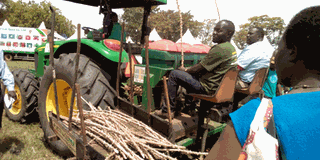Planter makes farm work easier

Seeds of Gold team testing the planter during the Farm Clinic in Serere District. Photo by George Muron.
What you need to know:
The tractor planter has two plastic hoppers mounted parallel on it. One of the hoppers hosts seeds such as maize, beans, sorghum or millet, which are the common crops grown in the area while the other hosts cassava cuttings, writes George Muron
Planting several acres of land by hand can be tedious and it could go on for several days. This increases the cost of labour for the farmer.
In the normal planting system, first, farmers till the land, probably twice, before employing workers, especially females to sow the seeds manually.
Mechanised planter
John Patrick Okello, a farmer in Mukongoro County, Kumi District, however, does it differently and easily, using a tractor that saves him a great deal.
The farmer who bought the planter two years ago, attaches the single row planter onto the tractor that sows cassava cuttings in a row throughout the fields. It can plant at least six acres a day.
Costs
Moses Mugeni, the sales executive at Cooper Motors, says a simple tractor costs between Shs100m to Shs200m depending on the country of importation and the engine size.
“The newest New Holland tractor TT490 has been tailor-made for farmers in eastern Uganda and comes at the cheapest price. It accommodates other utilities used for irrigation, planting, slashing and spraying pesticides and applying fertilisers, making it a must have all-in-one machine,” says Mugeni.
Advantages
Tom Omara, a cassava research officer at the National Agricultural Research Organisation (Naro) who facilitated at the recent Seeds of Gold Farm Clinic in Serere District, says the beauty about the mechanised cassava planter is that it allows an adjustable distance between the planting rows from 85 to 95 centimetres, which ensures high yields.
The agronomist adds that between plants in the row, the mechanised cassava planter is also adjustable between 40 and 100 centimetres.
Omara says the machine operates through a hydraulic lifting system, with an automatic cutting of stakes at five centimetres each stake, from the cassava stem. “For each day, this mechanised planter can plant five to seven hectares, with the very thinnest labour demand of two people plus tractor driver,” he says.
“The cost of labour for ploughing is subsidised to Shs90,000, second ploughing Shs70,000 and Shs50,000 for planting,” the agronomist explains.
Farmers can contribute in a group and buy the planter. “We advice farmers to jointly aquire these tractors,” says Omara.
Yields
Under good management, he says yields planted using mechanisation give an average harvest of 15 to 20 tonnes of cassava per hectare from improved cassava varieties of Narocas one and two, varieties released in 2015.
John Omongot, a farmer based in Ngora District, said if the mechanised cassava planter is up for hire, then he will be the first to rush come next farm season.
“I am very excited about technology. This tractor will help me increase production of cassava on my farm,” says Omongot.




